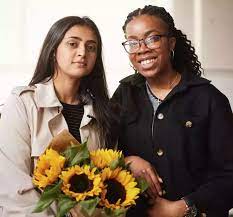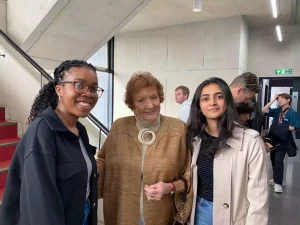#Breast #Cancer #Detecting #Tool #Dotplot #Wins #Dyson #Award
Welcome guys to All Social Updates. Here you can Find complete information about all the latest and important updates about every matter from all around the world. We cover News from every niche whether its big or small. You can subscribe and bookmark our website and social media handles to get the important news fastest before anyone.Follow our website allsocialupdates.com on Facebook, Instagram , Twitter for genuine and real news.
Shefali Bohra and Debra Babalola: Who Are They? Breast Cancer Detecting Tool Dotplot Wins UK Dyson Award 2022
Shefali Bohra, an Imperial College London student of Indian heritage, and Debra Babalola, another Imperial College London student, received this year’s James Dyson Award. This honor goes to two young women together for their work on a breast-checking device. The technology Shefali and Debra developed also creates a unique, customized map of each person’s breast to track the growth of any tumors that may appear.
One of the most important awards given in the UK is the James Dyson prize. That name was given in honor of the famous British entrepreneur and inventor James Dyson, who also founded the award. This prestigious international design award is given annually and is accessible to both college students and graduates of their respective universities. James Dyson is incredibly wealthy and is considered one of the richest men in Britain. The winners of this year’s award for their work on the Dot plan, which has the ability to detect breast cancer, are Shefali Bohra and Debra, both of Indian descent. They both recently graduated from the renowned Imperial College in London, England, where they both studied. Both young women have come up with an innovative idea that has potential uses.
The device created by Shefali and Debra can record the tissue composition of each region in the breast using soundwaves, similar to those used in ultrasound. To determine how specific areas of the breast may change over time, the application generates a report after each scan that can be compared with data from previous months. The work that resulted from their creative thinking is said to have received immense praise and enthusiasm from people all over the world. All the people who are currently suffering from the painful effects of this disease can benefit greatly from this breakthrough.
Shefali and Debra’s Dot plan has the potential to help women better maintain a regular breast self-examination, which can help with earlier detection of breast cancer. According to reports, Shefali and Debra, who are in charge of making it, are being thanked and praised by users across social media platforms for their work. The growth of these cells may mark the beginning of a new phase in the battle against breast cancer. A large proportion of women are diagnosed with breast cancer worldwide, and a large proportion of those women die from this devastating disease. These patients stand to gain significantly from this breakthrough. Shefali and Debra, the people behind the Dot plot, are currently shrouded in mystery and little is known about them. Keep coming back to us for the latest news, information, and updates at both the national and global levels.


Shefali Bohra and Debra Babalola
The device created by Debra and Shefali
- Sliding the handheld gadget allows the Dotplot user to create a personalized map of their body.
- After it is prepared, the app assists women in performing a self-check by identifying which parts of their body need to be checked.
- To record the composition of the tissue at each location, a sound signal is generated.
- The reading for each month is compared to readings taken in previous months.
- Innovators used sound waves as a method for finding tumors.
- Readings in regions with tumors and those without tumors are very different from each other.
- This helps draw attention to any abnormalities that may be developing in the tissue.
- In case the gadget detects any abnormal changes in the breast tissue, it will ensure that the users are aware of these findings.
- It goes so far as to inform the user that they should consult a medical professional to perform further tests.
- This is not the final word on one’s breast health, but rather the beginning of further investigation into the problem.
How did these pairs of design engineers get their ideas?
Shefali noticed that one of her breasts had a strange lump after finishing one of her gym workouts. After visiting the doctor, the knot thankfully resolved itself. That was enough to motivate Shefali and Debra to investigate whether or not tools existed to help women regularly check their breasts for changes.
Shefali said: “We set ourselves the goal of inventing a device that could allow women to perform self-examinations with clarity, ease, and confidence. We were amazed to realize that there were no available gadget that will help women in performing breast self-check.
“Our success in the James Dyson Award competition validates the idea that Dotplot deserves further investigation. Throughout the product design process, but especially when you feel discouraged, you will need that motivation .
The Dotplot project, which Debra and Shefali collaborated on, will receive a £5,000 grant as a result of their success in the national James Dyson Award competition. That is almost 500,000 rupees. I hope that this prototype device will soon be replaced by a more affordable, mass-produced one available in every home. The world may need your help to end cancer soon.
About the James Dyson Award
An international student design competition called the James Dyson Competition challenges young people to “make something that addresses a problem.” The prize bears the name of the creator of the vacuum cleaner. Students currently enrolled in colleges and universities, as well as recent graduates working in engineering, industrial design, or product design, are eligible to enter the competition. The prize is administered by the James Dyson Foundation, a nonprofit foundation founded by James Dyson with the aim of stimulating young people’s interest in design engineering.
To be eligible, students must attend school in one of the following countries or territories: Any of the following countries: Australia, Austria, Belgium, Canada, China, France, Germany, Ireland, India, Italy, Japan, Korea, Malaysia, Netherlands, New Zealand, Russia, Singapore, Spain, Sweden, Switzerland, Taiwan, United Kingdom, or United States of America.
Four finalists and one national champion will be selected at the end of each country’s competition. For the ultimate prize, James Dyson will select one winner from outside the country.


Shefali Bohra and Debra Babalola
History of Winners
-
International winners
- 2007 Maxi Pantel (Germany) for Senjoan electronic device for the deaf to communicate with the hearing.
- 2008 Michael Chen (England) for Reactivea motion-activated LED safety jacket for cycling.
- 2009 Yusuf Muhammad and Paul Thomas (England) for Automista kitchen-faucet sprinkler system that controls residential fires.
- 2010 Samuel Adeloju (Australia) for Longreachwater floating device for rescuing victims in water.
- 2011 Edward Linacre (Australia) for Airdropcaptures water from the air and delivers it directly to plant roots through a network of underground pipes.
- 2012 Dan Watson (England) for SafetyNeta new commercial fishing net to allow smaller, unwanted fish to escape.
- 2013 University of Pennsylvania team (United States) for Titan Arm, a bionic arm. The arm was developed for the Cornell Cup USA 2013 competition where they won first place. Award: $45,000 + $16,000 to the University.
- 2014 James Roberts (Loughborough University, England) for MOM, a portable inflatable incubator. Award: $45,000 + $5,000 to the University.
- 2015 University of Waterloo team (Canada) for Voltera V-One, a laptop-sized printed circuit board printer. Award: $45,000 + $7,500 to the University.
- 2016 Isis Shiffer (Pratt Institute, United States) for EcoHelmeta paper bicycle helmet.[25] Award: $45,000.
- 2017 Michael Takla, Rotimi Bhavsar, Prateek Mathur (McMaster University) for The sKan a device that uses thermal maps of the skin to detect melanomas.
- 2018 Nicolas Orellana, Yaseen Noorani (Lancaster University) for the O-Wind Turbine.
- 2019 Lucy Hughes (UK) for MarinaTex, a biodegradable plastic made from fish off cuts.
- 2020 Judit Giró (University of Barcelona and University of California, Irvine) for The Blue Boxa biomedical device for painless, non-irradiating, low-cost, at-home breast cancer screening.
- 2021 Kelu Yu, Si Li and David Lee (National University of Singapore) for HOPES, a device for painless, at-home eye pressure testing, opening access to glaucoma testing. Joseph Bentley (Loughborough University, England) for REACT, a bleeding-derived technology to help save the lives of stabbing victims. Jerry de Vos (Delft University of Technology) for the Plastic Scanner, a low-cost, handheld device to identify plastic for recycling.
- 2022 Shefali Bohra and Dera Babalola for Breast Cancer Detecting Tool Dotplot.
